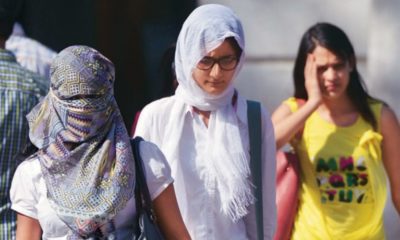Feature
Good news for HIV patients as this pill going to curb 2.7 lakh Aids cases

New Delhi: Paired with a biannual testing programme, a combination drug used to prevent HIV infection has the potential to improve average per-person survival by nearly one year and block more than 270,000 HIV transmissions in India over a period of 15 years, says a study.
The once-a-day pill, called pre-exposure prophylaxis (PrEP), can reduce the risk of HIV acquisition by over 85 per cent when taken consistently.
The new study, published in the journal Clinical Infectious Diseases, suggests that making PrEP available to men who have sex with men (MSM) and people who inject drugs (PWID) in India may be a cost-effective way of curbing the epidemic in the country.
“We know PrEP helps stop the spread of infection; the question is whether it is a good use of limited resources? Our study shows that PrEP is a cost-effective strategy for both MSM and PWID in India. For these groups, especially in areas with high HIV incidence, PrEP is worth rolling out,” says lead and corresponding author Pooyan Kazemian of the Massachusetts General Hospital (MGH) in the US.
Using a widely-published mathematical model to project clinical and economic outcomes of HIV disease, the authors compared various prevention and testing programmes – including annual or biannual HIV testing alone, as well as PrEP paired with HIV testing – that could help reduce HIV infection and therefore improve survival for these high-risk groups.
This pill helps to curb 2.7 lakh HIV cases in India for survival of Aids patients:
Their findings suggest that PrEP would increase survival substantially by reducing infection risk, while more frequent HIV testing would provide little additional benefit.
“While the World Health Organization recommends quarterly HIV testing for those on PrEP, our analysis identifies PrEP with semi-annual testing as the cost-effective HIV prevention strategy for MSM and PWID in India,” said co-author Nagalingeswaran Kumarasamy of the Voluntary Health Services in Chennai.
However, the authors noted that a nationwide PrEP rollout would be quite costly.
If nearly 60 per cent of MSM and PWID across India participated in the programme, it would increase HIV care expenditures by over $900 million over a five-year period, the study said.
“Our findings suggest that geographic areas of highest HIV incidence should be targeted first to reduce the budget required,” said co-author Nomita Chandhiok of the Indian Council of Medical Research in New Delhi.
Entertainment
Meghalaya Reserves Legalized Gambling and Sports Betting for Tourists

The State Scores Extra High on Gaming-Friendly Industry Index
Meghalaya scored 92.85 out of 100 possible points in a Gaming Industry Index and proved to be India’s most gaming-friendly state following its recent profound legislation changes over the field allowing land-based and online gaming, including games of chance, under a licensing regime.
The index by the UK India Business Council (UKIBC) uses a scale of 0 to 100 to measure the level of legalisation on gambling and betting achieved by a state based on the scores over a set of seven different games – lottery, horse racing, betting on sports, poker, rummy, casino and fantasy sports
Starting from February last year, Meghalaya became the third state in India’s northeast to legalise gambling and betting after Sikkim and Nagaland. After consultations with the UKIBC, the state proceeded with the adoption of the Meghalaya Regulation of Gaming Act, 2021 and the nullification of the Meghalaya Prevention of Gambling Act, 1970. Subsequently in December, the Meghalaya Regulation of Gaming Rules, 2021 were notified and came into force.
All for the Tourists
The move to legalise and license various forms of offline and online betting and gambling in Meghalaya is aimed at boosting tourism and creating jobs, and altogether raising taxation revenues for the northeastern state. At the same time, the opportunities to bet and gamble legally will be reserved only for tourists and visitors.
“We came out with a Gaming Act and subsequently framed the Regulation of Gaming Rules, 2021. The government will accordingly issue licenses to operate games of skill and chance, both online and offline,” said James P. K. Sangma, Meghalaya State Law and Taxation Minister speaking in the capital city of Shillong. “But the legalized gambling and gaming will only be for tourists and not residents of Meghalaya,” he continued.
To be allowed to play, tourists and people visiting the state for work or business purposes will have to prove their non-resident status by presenting appropriate documents, in a process similar to a bank KYC (Know Your Customer) procedure.
Meghalaya Reaches Out to a Vast Market
With 140 millions of people in India estimated to bet regularly on sports, and a total of 370 million desi bettors around prominent sporting events, as per data from one of the latest reports by Esse N Videri, Meghalaya is set to reach out and take a piece of a vast market.
Estimates on the financial value of India’s sports betting market, combined across all types of offline channels and online sports and cricket predictions and betting platforms, speak about amounts between $130 and $150 billion (roughly between ₹9.7 and ₹11.5 lakh crore).
Andhra Pradesh, Telangana and Delhi are shown to deliver the highest number of bettors and Meghalaya can count on substantial tourists flow from their betting circles. The sports betting communities of Karnataka, Maharashtra, Uttar Pradesh and Haryana are also not to be underestimated.
Among the sports, cricket is most popular, registering 68 percent of the total bet count analyzed by Esse N Videri. Football takes second position with 11 percent of the bets, followed by betting on FIFA at 7 percent and on eCricket at 5 percent. The last position in the Top 5 of popular sports for betting in India is taken by tennis with 3 percent of the bet count.
Local Citizens will Still have Their Teer Betting
Meghalaya residents will still be permitted to participate in teer betting over arrow-shooting results. Teer is a traditional method of gambling, somewhat similar to a lottery draw, and held under the rules of the Meghalaya Regulation of the Game of Arrow Shooting and the Sale of Teer Tickets Act, 2018.
Teer includes bettors wagering on the number of arrows that reach the target which is placed about 50 meters away from a team of 20 archers positioned in a semicircle.
The archers shoot volleys of arrows at the target for ten minutes, and players place their bets choosing a number between 0 and 99 trying to guess the last two digits of the number of arrows that successfully pierce the target.
If, for example, the number of hits is 256, anyone who has bet on 56 wins an amount eight times bigger than their wager.

























